Winifred was the daughter of James and Susan (Crawford] McKissack and was born on April 27th, 1910 in Newcastle upon Tyne. She married Evan Finlay, a college lecturer, in July 1935 and they had one daughter called Gillian. Winifred attended King's College (now Newcastle University) where she gained an M.A. in English Literature and met her future husband who was a fellow student. During the years 1933-35 she was a schoolmistress and college lecturer in Newcastle and in the Second World War she continued to teach in Stratford Upon Avon.
In 1945 Evan, Winifred and Gillian moved to Northampton where Evan became the Head of the Department of Commerce in Northampton College of Technology. During the Second World War there was a shortage of reading matter that was suitable for young Gillian and so, Winifred, who had been an avid writer from the age of 9, began to create again tales of her own. After a while she was encouraged to submit scripts to "Children's Hour" at the BBC and several radio plays were then transmitted. Then, in 1951, her first full-length novel for children, "The Witch of Redesdale", was published by Harrap.
.Over the years another 20 books followed in its wake. Later in her life Winifred began to compile collections of folk tales, legands and true stories. She sometimes collaborated with her daughter (married name Gillian Hancock) on these volumes. The second half of Winifred's life was spent in Northamptonshire, mostly at her home in "The Old House" in Walcote near Northampton. As she grew older illness made her housebound and the journeys made to do her research became impossible. Thus she found herself relying more and more on reference books. Before her death in 1989, at the age of 79, Winifred had become blind and had to give up her the writing she loved so much.
Books
BOOKS FOR CHILDREN:
The Witch of Redesdale 1951
Peril in Lakeland 1953
Peril in the Pennines 1953
Cotswold Holiday 1954
The Lost Silver of Langdon 1955
Storm Over Cheviot 1955
Judith in Hanover 1955
Canal Holiday 1957
The Cruise of the “Susan” 1958
The Castle and the Cave 1960
The Lost Emeralds of Black Howes 1961
Alison in Provence 1963
Mystery in the Middle Marches 1964
Castle for Four 1966
Adventure in Prague 1967
Danger at Black Dyke 1968
The Cry of the Peacock 1969
Summer of the Golden Stag 1969
Singing Stones 1970
Beadbonny Ash 1973
COLLECTIONS OF FOLK TALES AND TRUE STORIES:-
Folk Tales from the North 1969
Folk Tales from Moor and Mountain 1969
Cap o’ Rushes and Other Folk Tales 1974
Tattercoats and Other Folk Tales 1977
Ghosts, Ghouls and Spectres (with Gillian Hancock) 1977
Spies and Secret Agents (with Gillian Hancock) 1977
Treasure Hunters (with Gillian Hancock) 1978
Tales from the Hebrides and Highlands 1978
Clever and Courageous Dogs (with Gillian Hancock) 1978
Famous Flights of Airships and Balloons (with Gillian Hancock) 1979
Tales from the Borders 1979
Tales of Sorcery and Witchcraft 1980
Tales of Fantasy and Fear 1980
Fight for Life 1981
Secret Rooms and Hiding Places 1982
Vampires, Werewolves and Phantoms of the Night: Demonic Tales from Different Lands 1983
The Witch of Redesdale
The Witch of Redesdale in 1951 was Winifred Finlay's first book. She had already served her apprenticeship by writing scripts for BBC radio plays and serialisations for "Children's Hour" and had very clear ideas about what was required for a children's adventure story. Each of the settings in Newcaslte and Northumberland was clear in her mind from the days of her youth. The book is prefaced by a simple sketch map of the county of Northumberland and the route taken from Newcastle Central Station to the wilds of the countryside near the Scottish border.
The main characters are the four young people Gillian (in honour of Winifred's daughter), Sally, Peter and Bryan who plan to spend a holiday together at Youth Hostels and at the house of Bryan's aunt in Redesdale. Throughout each story concerning these teenagers (see also Peril in Lakeland and Peril in the Pennines) it is made clear that the boys and girls are friends and that the enjoyment of each others' company, albeit with constant outbreaks of bantering and teasing, is all that is on the agenda. There is no incipient romance involving any of the characters. As Finlay developed as a writer, and as her daughter Gillian grew up, more adult concerns began to emerge in her stories, particularly those involving the Norton family.
It is not the business of this reviewer to give away all that happens in this story, merely to give you flavour of what you can expect to find when you read it yourself. Let us, therefore, mention some of the particular attractive ingredients. The "Prologue to Adventure" is a first-rate description of what it is like to experience the famous Newcastle "Hoppings", the large open air fair that makes its way to the Town Moor of that northern city every June. The author captures the atmosphere perfectly, reflecting accurately both the accent and the dialect words that bounce off the eardrums of Gill and Sally as they make their way through the throngs of Geordies out for a day of enjoyment. It is not until much later in the book that the reader realises that one of the essential plot ingredients, a key part of the mystery, has been planted in a remote corner of his or her mind. It will later emerge into the foreground when the writer judges her moment.
The story really gets under way when the train pulls into Newcastle Central Station and the four children are reunited amidst the bedlam of the crowded platforms. Meticulous attention is paid to the authenticity of the journey through the city and out into the country. Gill, in particular, revels in the ballads and stories that concern the hills and valleys around her. Realistic accounts of Youth Club Life are balanced by disturbing descriptions of eerie woods and other stretches of lonely countryside.
The characters that they (and we) meet are refreshingly a mixture of the everyday and the extraordinary. There is a perceptive view given of the workings of a remote rural community, where every oddity is treated with both suspicion and superstition. The cantankerous and enigmatic personality of Old Madge stirs up both dread and pity. The children's attempts to help her and solve the mystery are both touching and amusing. Inevitably the resolution of the plot provides its share of anticlimax for the author, at this time in her career, wanted to provide her readers with a firm footing in the real world. On the strength of this first novel Harrap accepted two more stories about the same collection of characters in the years which immediately followed.
The Norton Family
In one way the Norton family existed before the first book about them appeared on the market. This is because they had a previous incarnation as characters in various radio serials. The one I have details for is The Lindisfarne Mystery which was broadcast by the BBC in January 1956. The Radio Times for December 30th, 1955 carries an article by Winifred herself which is reproduced elsewhere on this site. In it she refers to Joan Norton, one of the two younger children, but no Joan ever appears in the books. On paper the cast list is restricted to young Richard (Dicky), his older brother called Paul, and Judith, the eldest of the siblings. Of course, there are also the mother and their Uncle Bill who play a significant part in some of the stories.
The cast list for January 6th tell us that the part of Judith was played by the now well-known Holiday Travel presenter Judith Chalmers. Young Richard was played by Scot Finch. The play is billed as "For Older Listeners" and "Another Adventure of the Norton Family". The use of children and young adults at different ages enabled Winifred to spread the appeal of both the serials and the books. Richard often lived in the fantasy world that is so appealing and yet so often jars with grim reality. Paul, on the other hand, is beginning to discover the pains and pleasures of having a girlfriend, whilst Judith moves from the peril of "A" levels to the apprehensions of a first journey abroad without the protective shield of the family.
Amongst other books you can encounter the adventures of the Norton Family in The Lost Silver of Langdon 1955, Storm Over Cheviot 1955, Judith in Hanover 1955, The Lost Emeralds of Black Howes 1961, and Castle for Four 1966.
THE LINDISFARNE MYSTERY
An island with a castle and a ruined priory, connected to the Northumbrian coast at low tide by three miles of yellow sands but cut off entirely at high water - what a setting for an exciting adventure ! So I thought when I was twelve years old and when I first walked bare-footed across the wet sand, following the old Pilgrim's Way with the gaunt wooden refuge boxes perched high on stilts. I thought it every time I went back to Holy Island, and then last year, with a possible plot in mind, I went to stay there and to see if the idea could be worked out.
The Nortons would love this place, I knew. Richard and Joan, the two younger, argumentative ones would explore the sandy beaches and rocky headlands, and Judith and Paul would have their work cut out looking after them. They would stay with an old fisherman and his wife and they would meet other visitors to the island. The most important part would be played not by a person but by the sea which rushes in on both sides of the island to trap those who try to cross too late. But just how dangerous and cruel the sea was, I did not appreciate until I met the radio mechanic and engineer of the Gertrude - the Holy Island lifeboat - and from him and from other islanders too, I heard tales of storms and gales and sea-rescues. And because of all they told me I scrapped my plot and set to work on a new one.
So it is that the Nortons cross as I did the last time by the Island taxi which has to be seen - and heard ! - to be believed. Joan, thirsting for mystery and adventure, soon finds both in the strange behaviour of the other visitors. Once the islanders were reputed to be smugglers and wreckers
Is this all past ? Who was the mysterious stranger that she and Richard met when they went to Dunstanburgh Castle in search of Sir Guy the Seeker ? What was the meaning of the message in code that came from the sea? What happened when someone who was frightened tried to cross to the island when the breakers had already begun to roll in from the north and from the south ?
If you like this play - beginning in Children's Hour on Friday - remember that the Holy Island of Lindisfarne really exists: go there and see the castle and the priory, the seals and the birds and the lifeboat. You won't be disappointed. But watch the tides - they're very real too !
(Winifred Finlay, Radio Times, 20th December, 1955)
Portrait of Winifred
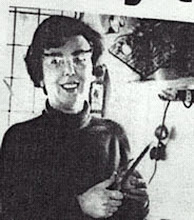
Subscribe to:
Post Comments (Atom)


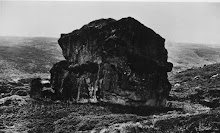
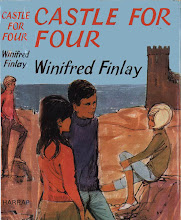


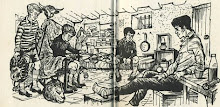
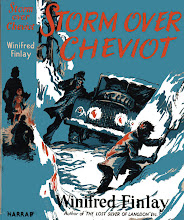
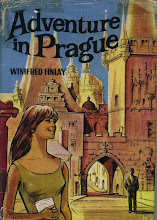
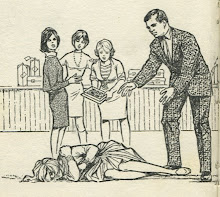


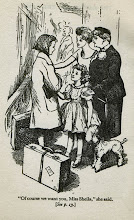
This is wonderful Jan- Win was my grandmother. I think it's the first page about her on the internet! I'll send a link to my mum who's the basis for some of teh characters!
ReplyDeleteJohn
I recently wrote a story based on "The Fair Maid and the Snow-White Unicorn," which appears in Tales for Moor and Mountain by Winifred Finlay (New York; Roy, 1969), and I was wondering what the copyright/fair use privileges were on that folktale. As her grandson, do you know any information on her copyright information, or would you be willing to read my story and grant me permission to use Finlay's folktale?
DeleteI am so glad that you got in touch and passed on the information to your mother. She will tell you that my name is Jim Mackenzie, a retired teacher in Newcastle Upon Tyne. I research children's books of the past,especially ones which have northern settings. I have just arranged for a copy of my first book which contains my reflections on several of Winifred's books to be sent to her. I am happy to write more and would love to know more.
ReplyDeleteThe Old House, where Winifred lived is in the village of Walgrave in Northamptonshire.
ReplyDeleteTHank you for this interesting information, I recently enjoyed Alison in Provence, and it is nice to know about her other books. I will look out for more of them.
ReplyDeleteChildren's Hour was an important part of the lives of myself and 4 siblings in the 1950s. I've been researching the serials that made a particular impact. I had already remembered Winifred Finlay and the Nortons, but not the names of the stories. Judith Norton was played in some of the serials by Judith Chalmers, who frequently appeared in Children's Hour serials. The memorable theme music for the Norton serials as the opening of the 3rd movement of Dvorak's 7th symphony. "Storm over Cheviot" gave me a healthy respect for the Carter Bar road which providentially helped me avoid a dangerous situation some 20 years later.
ReplyDelete